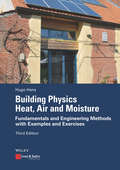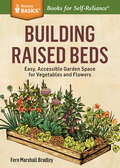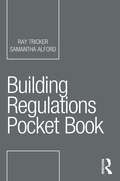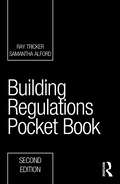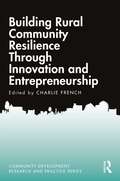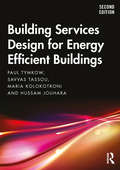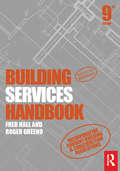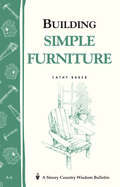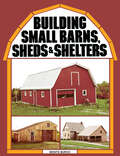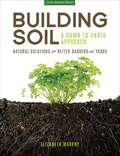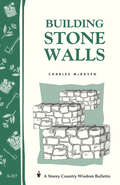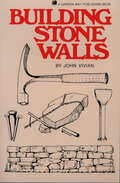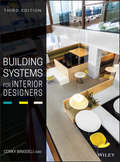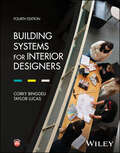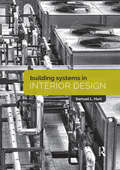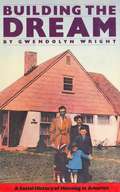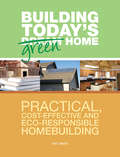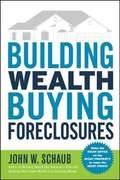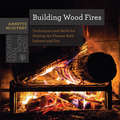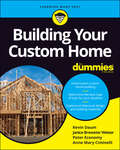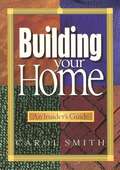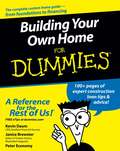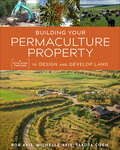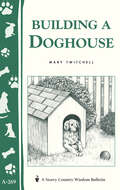- Table View
- List View
Building Physics - Heat, Air and Moisture: Fundamentals and Engineering Methods with Examples and Exercises
by Hugo S. HensBad experiences with construction quality, the energy crises of 1973 and 1979, complaints about "sick buildings", thermal, acoustical, visual and olfactory discomfort, the need for good air quality, the move towards more sustainability - all these have accelerated the development of a field that, for a long time, was hardly more than an academic exercise: building physics (in English speaking countries sometimes referred to as building science). The discipline embraces domains such as heat and mass transfer, building acoustics, lighting, indoor environmental quality and energy efficiency. In some countries, fire safety is also included. Through the application of physical knowledge and its combination with information coming from other disciplines, the field helps to understand the physical phenomena governing building parts, building envelope, whole buildings and built environment performance, although for the last the wording "urban physics" is used. Today, building physics has become a key player on the road to a performance based building design. The book deals with the description, analysis and modeling of heat, air and moisture transport in building assemblies and whole buildings with main emphasis on the building engineering applications, including examples. The physical transport processes determine the performance of the building envelope and may influence the serviceability of the structure and the whole building. Compared to the second edition, in this third edition the text has partially been revised and extended.
Building Raised Beds: Easy, Accessible Garden Space for Vegetables and Flowers. A Storey BASICS® Title (Storey Basics)
by Fern Marshall BradleyFor beginning gardeners and homeowners, this handbook shows you exactly how to plan, build, and plant a simple raised bed. Fully illustrated step-by-step instructions make it easy and ensure success! In just a weekend, using a few basic materials and minimal building skills, you can set up a complete garden bed adapted for vegetables, flowers, or herbs.
Building Regulations Pocket Book (Routledge Pocket Books)
by Ray Tricker Samantha AlfordThis handy guide provides you with all the information you need to comply with the UK Building Regulations and Approved Documents. On site, in the van, in the office, wherever you are, this is the book you’ll refer to time and time again to double check the regulations on your current job. The Building Regulations Pocket Book is the must have reliable and portable guide to compliance with the Building Regulations. Part 1 provides an overview of the Building Act Part 2 offers a handy guide to the dos and don’ts of gaining the Local Council’s approval for Planning Permission and Building Regulations Approval Part 3 presents an overview of the requirements of the Approved Documents associated with the Building Regulations Part 4 is an easy to read explanation of the essential requirements of the Building Regulations that any architect, builder or DIYer needs to know to keep their work safe and compliant on both domestic or non-domestic jobs This book is essential reading for all building contractors and sub-contractors, site engineers, building engineers, building control officers, building surveyors, architects, construction site managers and DIYers. Homeowners will also find it useful to understand what they are responsible for when they have work done on their home (ignorance of the regulations is no defence when it comes to compliance!).
Building Regulations Pocket Book (Routledge Pocket Books)
by Ray Tricker Samantha AlfordThe new edition of the Building Regulations Pocket Book has been fully updated with recent changes to the UK Building Regulations and Planning Law. This handy guide provides you with all the information you need to comply with the UK Building Regulations and Approved Documents. On site, in the van, in the office – wherever you are – this is the book you’ll refer to time and time again to check the regulations on your current job. Part 1 provides an overview of the Building Act. Part 2 offers a handy guide to the dos and don’ts of gaining the Local Council’s approval for Planning Permission and Building Regulations Approval. Part 3 presents an overview of the requirements of the Approved Documents associated with the Building Regulations. Part 4 is an easy-to-read explanation of the essential requirements of the Building Regulations that any architect, builder or DIYer needs to know to keep their work safe and compliant on both domestic and non-domestic jobs. Key new updates to this second edition include, but are not limited to: changes to the fire regulations as a result of the Hackitt Review, updates to Approved Document F and L, new Approved Documents covering Overheating (AD-O) and Infrastructure for the charging of electric vehicles (AD-S), amendments to and the reinstatement of the Manual to the Building Regulations. This book is essential reading for all building contractors and sub-contractors, site engineers, building engineers, building control officers, building surveyors, architects, construction site managers as well as DIYers and those who are supervising work in their own home.
Building Rural Community Resilience Through Innovation and Entrepreneurship (Community Development Research and Practice Series)
by Charlie FrenchDrawing from empirical analyses, case studies, and a synthesis of best practices, this book explores how innovation manifests itself in rural places and how it contributes to entrepreneurial development and resilience. Innovation in rural places may come about as a result of new forms of collaboration; policies that leverage rural assets and address critical service or product gaps; novel strategies for accessing financial capital; infusion of arts into aspects of community life; and cultivation of networks that bridge entrepreneurs, organizations, and institutions. The chapters illustrate how a number of innovation-related characteristics relate to economic vibrancy in rural places such as a strong connection to the arts, adaptive and sustainable use of natural resources, value-chain integrated food systems, robust bridging social capital networks, creative leveraging of technology, and presence of innovation-focused entrepreneurs. Through exploration of these and other topics, this book will provide insights and best practices for rural community and economic development scholars and practitioners seeking to strengthen the rural innovation ecosystem.
Building Rural Community Resilience Through Innovation and Entrepreneurship (ISSN)
by Charlie FrenchDrawing from empirical analyses, case studies, and a synthesis of best practices, this book explores how innovation manifests itself in rural places and how it contributes to entrepreneurial development and resilience. Innovation in rural places may come about as a result of new forms of collaboration; policies that leverage rural assets and address critical service or product gaps; novel strategies for accessing financial capital; infusion of arts into aspects of community life; and cultivation of networks that bridge entrepreneurs, organizations, and institutions. The chapters illustrate how a number of innovation-related characteristics relate to economic vibrancy in rural places such as a strong connection to the arts, adaptive and sustainable use of natural resources, value-chain integrated food systems, robust bridging social capital networks, creative leveraging of technology, and presence of innovation-focused entrepreneurs. Through exploration of these and other topics, this book will provide insights and best practices for rural community and economic development scholars and practitioners seeking to strengthen the rural innovation ecosystem.
Building Services Design for Energy Efficient Buildings
by Paul Tymkow Savvas Tassou Maria Kolokotroni Hussam JouharaThe role and influence of building services engineers are undergoing rapid change and are pivotal to achieving low-carbon buildings. However, textbooks in the field have tended to remain fairly traditional with a detailed focus on the technicalities of heating, ventilation and air-conditioning (HVAC) systems, often with little wider context. This book addresses that need by embracing a contemporary understanding of the challenge to address climate change, together with practical approaches to energy efficiency and carbon mitigation for mechanical and electrical systems, in a concise manner. The essential conceptual design issues for planning the principal building services systems that influence energy efficiency are examined in detail. These are HVAC and electrical systems. In addition, the following issues are addressed: background issues on climate change, whole-life performance and design collaboration generic strategies for energy efficient, low-carbon design health & wellbeing and post-occupancy evaluation building ventilation air-conditioning and HVAC system selection thermal energy generation and distribution systems low-energy approaches for thermal control electrical systems, data collection, controls and monitoring building thermal load assessment building electric power load assessment space planning and design integration with other disciplines. In order to deliver buildings that help to mitigate climate change impacts, a new perspective is required for building services engineers, from the initial conceptual design and throughout the design collaboration with other disciplines. This book provides a contemporary introduction and guide to this new approach, for students and practitioners alike.
Building Services Handbook
by Roger Greeno Fred HallThe ninth edition of Hall and Greeno's leading textbook has been reviewed and updated in relation to the latest building and water regulations, new technology, and new legislation. For this edition, new updates includes: the reappraisal of CO2 emissions targets, updates to sections on ventilation, fuel, A/C, refrigeration, water supply, electricity and power supply, sprinkler systems, and much more. Building Services Handbook summarises the application of all common elements of building services practice, technique and procedure, to provide an essential information resource for students as well as practitioners working in building services, building management and the facilities administration and maintenance sectors of the construction industry. Information is presented in the highly illustrated and accessible style of the best-selling companion title Building Construction Handbook. THE comprehensive reference for all construction and building services students, Building Services Handbook is ideal for a wide range of courses including NVQ and BTEC National through Higher National Certificate and Diploma to Foundation and three-year Degree level. The clear illustrations and complementary references to industry Standards combine essential guidance with a resource base for further reading and development of specific topics.
Building Simple Furniture: Storey Country Wisdom Bulletin A-06 (Storey Country Wisdom Bulletin Ser.)
by Cathy BakerEASY-TO-BUILD PROJECTS FOR THE WEEKEND WOODWORKER! <P><P>Look over the variety of simple wood-working projects in the bulletin and you’ll quickly find something that deserves a place in your home. A small table for the hallway, perhaps, or an Adirondack chair or picnic set for the deck or garden? <P><P>The good news is that you don’t need to be a master carpenter with a basement full of power tools to craft these handsome and practical items. With a few simple hand tools and Cathy Baker’s step-by-step instructions and easy-to-follow illustrations and diagrams, you can build sturdy, durable, beautiful wooden furniture that you and your family will enjoy for years to come. <P><P>Projects include:· <br> Wall shelf· <br> Small bench· <br> Picnic table and benches· <br> Adirondack chair· <br> Pump lamp· <br> Step stool· <br> Storage box· <br> Side table
Building Small Barns, Sheds & Shelters
by Monte BurchBuild your own outbuildings and enjoy the space to do more of what you love. From simple toolsheds and animal shelters to smokehouses and low-cost barns, Monte Burch guides you through everything you need to know to make your small building projects a reality. Detailed blueprints, easy-to-follow instructions, and expert advice are suited to even the first-time builder. Discover how easy it is to create your own customized spaces that will allow your passions to grow.
Building Soil: Natural Solutions for Better Gardens and Yards
by Elizabeth MurphyA down-to-earth, complete manual for achieving great gardening results with your own rich, organic soil.All the secrets to rich, sustainable soil are revealed to you. You’ll be amazed how easy it is to improve your garden or yard when you begin at ground level.Even experienced gardeners can be intimidated by soil. It isn’t just the soil-testing data and all the big words, like vermicompositing and mycorrhizal fungi. It’s also the fact that when you begin to work with the soil, you’re working with the very earth you grow in; you don’t want to make any mistakes. But with Building Soil as your guide, you can achieve your goal of rich, sustainable soil without the fear.Building Soil: A Down-to-Earth Approach is rich with practical, up-to-date information on how to grow and maintain healthy soils. Simple methods perfect for the home gardener’s use put healthy, organic soil within everyone’s reach. Because it’s written in plain language, you don’t need a degree in soil management to understand this book—you only need a yard or garden and the desire to improve it at the most basic level. By following author Elizabeth Murphy’s detailed instructions, you can become a successful soil-based gardener, whether you want to start a garden from scratch or improve an existing plot.Less weeding & laborLess water waste100% natural
Building Stone Walls: Storey's Country Wisdom Bulletin A-217
by Charles McRavenSince 1973, Storey's Country Wisdom Bulletins have offered practical, hands-on instructions designed to help readers master dozens of country living skills quickly and easily. There are now more than 170 titles in this series, and their remarkable popularity reflects the common desire of country and city dwellers alike to cultivate personal independence in everyday life.
Building Stone Walls: Storey's Country Wisdom Bulletin A-217
by John VivianRustic and charming or stately and proud, a well-built stone wall can add personality and beauty to your property. John Vivian’s lively approach and step-by-step instructions encourage you to transform a pile of rocks into an enduring landscape feature with gates, retaining walls, or stiles to suit your needs. Whatever unique challenges come with your site — poor drainage, sloping ground, or low-quality rubble material — Vivian offers innovative designs and reproducible methods to help you build a beautiful, long-lasting wall.
Building Systems for Interior Designers
by Corky BinggeliBuilding Systems for interior designersSecond EditionCorky Binggeli, asidThe updated guide to technical building systems for interior designersAs integral members of the building design team, interior designers share an increasingly complex and crucial role. Now revised in its second edition, Building Systems for Interior Designers remains the one go-to resource that addresses the special concerns of the interior designer within the broader context of the rest of the building design team. Building Systems for Interior Designers, Second Edition explains technical building systems and engineering issues in a clear and accessible way to interior designers. Covering systems from HVAC to water and waste to lighting, transportation, and safety, author Corky Binggeli enables interior designers to communicate more effectively with architects, engineers, and contractors; collaborate effectively on projects; and contribute to more accurate solutions for a broad range of building considerations.Among the many improvements in the Second Edition are: A deeper engagement with sustainable building design, giving the interior designer the resources needed to participate as part of a sustainable design team A reshaped structure that enhances the reader's understanding of the material Many more illustrations and explanatory captionsWith a host of features to make the book more up to date, easier to use, and more effective as an instructive guide, Building Systems for Interior Designers, Second Edition is a valuable book for students as well as a practical desktop reference for professionals.
Building Systems for Interior Designers
by Corky Binggeli Taylor LucasBUILDING SYSTEMS FOR INTERIOR DESIGNERS Make design decisions informed by technical and structural knowledge with this essential guide Professional interior design demands more than simply an understanding of aesthetic and artistic considerations; it also requires a detailed understanding of building systems and their interactions. Design decisions must account for mechanical and electrical equipment, building components, and structural elements, all of which can potentially shape a designer’s work. Building Systems for Interior Designers has long stood as the key to understanding and evaluating these elements, particularly key building systems like HVAC and plumbing, and their impacts on interior design. This Fourth Edition is fully updated to fit the needs of the CIDA certified interior design program and the NCIDQ exam. The fourth edition of Building Systems for Interior Designers also includes: Updated information on sustainable and energy-efficient design Detailed coverage of topics including security concerns, fire safety, and designing secure spaces Classroom supplements including sample construction documents, chapter specific discussion questions, and more Building Systems for Interior Designers is ideal for students in interior design courses and new professionals studying for NCIDQ exams.
Building Systems in Interior Design
by Samuel L. Hurt<p>Building Systems in Interior Design takes an entirely new approach to teaching this essential topic for Architects, Designers and Building Engineers. Written to prepare students for the real world and packed with practical examples, the book will foster an understanding of specific issues that are critical to those features of technical systems that most directly affect design. The book stresses the ever-present nature of these systems: they are everywhere, all the time. <p>Taking a design oriented view, it outlines what can and cannot be done, and provides the student with the know-how and confidence to defend and promote their design intent when working with other industry professionals. <p>Covering lighting, HVAC, plumbing and much more, the book is packed with key features to aid learning including: <p> <li>Numerous illustrations, plans and photographs <li>Key terms defined in an extensive glossary <li>Chapter introductions that identify key concepts and chapter summaries to re-visit those key concepts <li>Professional design tips <li>And a detailed bibliography and web links</li> <p> <p>This book is not only a core text for interior design, building systems engineering and architecture students but will become an essential working reference through their careers.</p>
Building The Dream
by Gwendolyn WrightFor Gwendolyn Wright, the houses of America are the diaries of the American people. They create a fascinating chronicle of the way we have lived, and a reflection of every political, economic, or social issue we have been concerned with. Why did plantation owners build uniform cabins for their slaves? Why were all the walls in nineteenth-century tenements painted white? Why did the parlor suddenly disappear from middle-class houses at the turn of the century? How did the federal highway system change the way millions of Americans raised their families?Building the Dream introduces the parade of people, policies, and ideologies that have shaped the course of our daily lives by shaping the rooms we have grown up in. In the row houses of colonial Philadelphia, the luxury apartments of New York City, the prefab houses of Levittown, and the public-housing towers of Chicago, Wright discovers revealing clues to our past and a new way of looking at such contemporary issues as integration, sustainable energy, the needs of the elderly, and how we define "family."
Building Today's Green Home: Practical, Cost-Effective and Eco-Responsible Homebuilding
by Art SmithMake Your Green Home a Reality! Building the right-sized green home involves making eco-smart decisions. In Building Today's Green Home, you will learn: How to choose the correct location of your building lot and what is the optimum placement of your house to take advantage of solar energy How to design the right-sized home for your needs now and in the future What are the best sustainable construction materials to use for building your home About the newest insulation materials and techniques What HVAC units are the most efficient and are the best at saving energy How to grade the building lot for natural sustainability The decisions you make today will have a huge impact on your future and the future of your children. And, building the right-sized energy-efficient home will free up investment capital for your retirement years.
Building Wealth Buying Foreclosures
by John W. Schaub<p>Foreclosures are one of the biggest real estate investment opportunities available in today's market. They also have a compelling benefit--when you buy a property on the brink of foreclosure, you're solving that problem for the previous owner, and getting a great deal in the process. <i>Building Wealth Buying Foreclosures</i> helps you target top properties and get the best deal, with tips on how to avoid scams, insight into the lender's perspective, and a checklist that helps you keep track of every step of the way. <p>Inside information on how to: <p> <li>Target only the right properties to buy <li>Negotiate the best price <li>Get a good deal on a mortgage <li>Make the right offer at the right time <li>Understand the lender's perspective <li>Make sense of title insurance <li>Decide to rent or sell the property</li> </p>
Building Wood Fires: Techniques And Skills For Stoking The Flames Both Indoors And Out (Countryman Know How #0)
by Annette McGivneyLearn everything there is to know about building a wood fire. Fire has brought humans together for millennia. The cozy warmth of the hearth and the adventure of the campfire draw the same attention today as they did 100 years ago. Part how-to, part history of fire, Building Wood Fires is an essential guide for anyone with a fireplace, backyard fire pit, or love of camping. Outdoor journalist and wilderness expert Annette McGivney shares years of expertise, providing tips from whereto build your fire pit to how to roast the perfect marshmallow and helpful diagrams to demonstrate essential techniques.
Building Your Custom Home For Dummies
by Peter Economy Kevin Daum Janice Brewster Anne Mary CiminelliBuild a place you’ll love to come home to Why settle for a house that looks like every other one in the neighborhood? With Building Your Custom Home For Dummies on your desk (right alongside those inspiring architecture magazines), you can design and build the home of your dreams. From brainstorming must-have features to hanging a wreath on the front door, this book walks you through what you need to know from start to finish. Get savvy on purchasing property, securing financing, and raising the walls that will become the setting for life’s next chapter. If you can imagine it, you can build it! Inside… Locate your ideal building site Hire an architecture and contracting team you can trust Finance smoothly and manage your construction budget Discover new green building techniques Oversee construction from A to Z Furnish, landscape, and maintain your property
Building Your Home: An Insider's Guide
by Carol SmithIn the second edition of Building Your Home: An Insider's Guide, customer service expert Carol Smith shows you how to work with your builder to create the home of your dreams. This guide is a must-have for anyone planning to build a high-quality home. With this comprehensive, step-by-step book, you can avoid common mistakes in the home building process and choose a qualified builder, establish your budget and secure financing, select the location, benefits, and features of your new home, participate effectively in the design and building process, prepare for home owner orientation, closing, and moving in, create a home maintenance plan, communicate with your builder on warranty service.
Building Your Own Home For Dummies
by Peter Economy Kevin Daum Janice BrewsterKeep construction on track with helpful checklists Turn your dream of a custom home into reality! Thinking about building your own home? This easy-to-follow guide shows you how to plan and build a beautiful home on any budget. From acquiring land to finding the best architect to overseeing the construction, you get lots of savvy tips on managing your new investment wisely -- and staying sane during the process! Discover how to: * Find the best homesite * Navigate the plan approval process * Obtain financing * Hire the right contractor * Cut design and construction costs * Avoid common mistakes
Building Your Permaculture Property: A Five-Step Process to Design and Develop Land (Mother Earth News Wiser Living Ser.)
by Rob Avis Michelle Avis Takota Coen&“A fresh, integrative, and holistic perspective on how to orientate oneself to the process of establishing your dreams and visions on the land.&” —Richard Perkins, author of Regenerative AgricultureBuilding Your Permaculture Property offers a revolutionary holistic method to overcome overwhelm in the complex process of resilient land design. It distills the authors&’ decades of experience as engineers, farmers, educators, and consultants into a five-step process complete with principles, practices, templates, and workflow tools to help you: Clarify your vision, values, and resources Diagnose your land and resources for strengths, weaknesses, opportunities, and threats Design your land and resources to meet your vision and values Implement the right design to enhance your strengths and improve your weakest resource Establish benchmarks to monitor the sustainability and success of your development. When designing a regenerative permaculture property, too many land stewards suffer from option paralysis, a lack of integrated holistic design, fruitless trial-and-error attempts, wasted money, and the frustration that results from too much information and no context.Building Your Permaculture Property is the essential guide for everyone looking to cut through the noise and establish an ecologically regenerative, financially sustainable, enjoyable, and thriving permaculture property, anywhere in the world. &“Highlights the need for permaculture design thinking in creating resilient, regenerative, landscapes and communities. Through this work, Rob, Michelle, and Takota make a valuable contribution to the ongoing evolution of permaculture thinking and action.&” —David Holmgren, permaculture co-originator &“Every farm, every ranch, and every homestead can benefit from thinking deeper about how human intent engages with the places we&’re blessed to call home.&” —Michael Phillips, author of The Holistic Orchard
Building a Doghouse: (Storey's Country Wisdom Bulletins A-269) (Storey Country Wisdom Bulletin Ser.)
by Mary TwitchellBuild a Doghouse That's Just Right for Your Dog!While your dog may be a full-fledged member of the family, there are times when you must put him or her outdoors. Some dogs, for example, become over enthusiastically friendly when visitors appear, even to the point of knocking down your unsuspecting guests. Other dogs enjoy having some time to themselves in the backyard. Whatever the reason that shepherds the dog out the door, a nearby doghouse within a fenced-in area provides a protected, private space for your dog and peace of mind for you. A proper doghouse is a canine retreat, a place where your dog can hide from the hot sun, the cold rain, the harsh wind, and the worries of the world. Mary Twitchell takes you through all the options for building or buying a comfortable and cozy shelter for your canine companion. Whether you want to modify a barrel, buy a molded plastic shelter, or build a wooden doghouse, you'll find all the information you need right here, from choosing the right site to proper building techniques to encouraging your dog to use the new doghouse.
